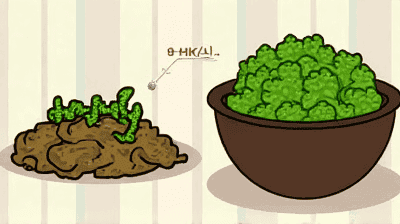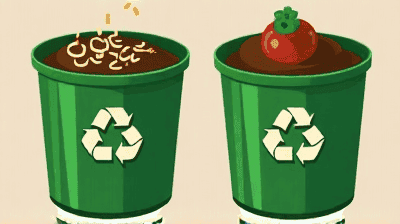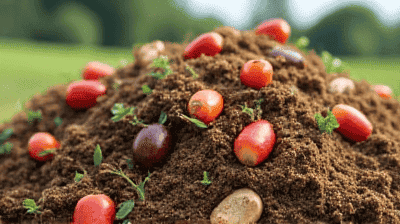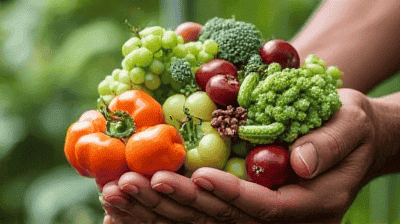
Food scraps are an inevitable byproduct of our daily lives, generated during meal preparation, consumption, and food processing. While these scraps might seem like mere waste, they hold immense potential for contributing to sustainable agriculture and reducing our environmental footprint. Two of the most effective methods for managing food scraps are composting and anaerobic digestion. Each method offers unique benefits and can play a crucial role in transforming organic waste into valuable resources.
Food waste is a major global issue, with estimates suggesting that approximately one-third of all food produced for human consumption goes uneaten. This waste occurs at various stages of the supply chain, from production and processing to retail and consumption. In developed countries, a significant portion of food waste happens in homes and restaurants, where food scraps are often discarded rather than repurposed.
When food waste is sent to landfills, it decomposes anaerobically, producing methane—a potent greenhouse gas that contributes to climate change. Additionally, the resources used to produce, transport, and store wasted food are significant; they include water, energy, and labor. By effectively managing food scraps through composting or anaerobic digestion, we can mitigate these environmental impacts and work towards a more sustainable food system.

Composting is a natural process that involves the decomposition of organic matter, such as food scraps and yard waste, by microorganisms under aerobic conditions. The result is nutrient-rich compost that can be used to enrich soil and promote healthy plant growth.
The composting process can generally be broken down into several stages:
Collection: Food scraps and other organic materials are collected in a dedicated compost bin or heap. Suitable materials include vegetable peels, fruit scraps, coffee grounds, eggshells, and yard waste like leaves and grass clippings.
Aeration: Oxygen is essential for aerobic decomposition. Compost piles should be turned regularly to introduce air and maintain aerobic conditions. Proper aeration ensures that microorganisms can thrive, speeding up the decomposition process.
Decomposition: Microorganisms, including bacteria and fungi, break down the organic matter into simpler compounds. This process generates heat, which further accelerates decomposition and reduces pathogens.
Maturation: Once the initial decomposition has occurred, the compost matures into a dark, crumbly substance known as compost. This can take anywhere from a few weeks to several months, depending on various factors such as temperature, moisture, and the balance of carbon and nitrogen in the compost pile.
Usage: Finished compost can be used as a soil amendment, providing essential nutrients to plants, improving soil structure, and enhancing water retention.
Soil Enrichment: Compost adds vital nutrients to soil, promoting healthy plant growth and improving soil structure and fertility.
Waste Reduction: Composting diverts food scraps from landfills, significantly reducing overall waste and associated greenhouse gas emissions.
Water Conservation: Compost improves soil's ability to retain moisture, reducing the need for irrigation and promoting drought resilience.
Biodiversity Support: Healthy soil enriched with compost supports diverse microbial communities, aiding in nutrient cycling and promoting ecosystem health.
Community Engagement: Composting can foster community engagement through shared composting programs, neighborhood composting facilities, and educational initiatives.
Space Requirements: Composting requires space for bins or piles, which may not be feasible in urban settings with limited outdoor areas.
Knowledge Gaps: Effective composting involves understanding the balance of carbon and nitrogen, moisture, and aeration. Lack of knowledge can lead to problematic compost piles that attract pests or produce unpleasant odors.
Time Consumption: Composting can take time, with the maturation process ranging from weeks to months, which may deter some individuals seeking quick solutions.
Anaerobic digestion is a biological process that decomposes organic matter in the absence of oxygen, resulting in the production of biogas (primarily methane) and digestate, a nutrient-rich material that can be used as a fertilizer.
The anaerobic digestion process consists of several key stages:
Feedstock Preparation: Organic materials, including food scraps, agricultural waste, and other biodegradable materials, are collected and prepared for digestion. This may involve shredding or mixing to facilitate easier decomposition.
Digestion: The prepared feedstock is placed in an anaerobic digester, an airtight container designed to maintain an oxygen-free environment. Microorganisms break down the organic materials, producing biogas and digestate.
Biogas Collection: The biogas produced during digestion is collected and can be used for various purposes, such as generating electricity, heating, or as a vehicle fuel.
Digestate Management: After digestion, the remaining material, known as digestate, is rich in nutrients and can be used as a soil amendment or fertilizer. It is often further processed or stabilized to reduce pathogens and odors.
Renewable Energy Production: Anaerobic digestion captures biogas, which can be used as a renewable energy source, reducing reliance on fossil fuels.
Waste Reduction: This method effectively diverts organic waste from landfills and reduces methane emissions associated with landfill decomposition.
Nutrient-Rich Fertilizer: The digestate produced through anaerobic digestion is a valuable fertilizer that can enhance soil health and nutrient availability.
Scalability: Anaerobic digestion systems can be designed for various scales, from small on-farm digesters to large municipal facilities, making them adaptable for different contexts.
Enhanced Pathogen Reduction: The anaerobic digestion process can significantly reduce pathogens in organic waste, resulting in a safer end product.
Capital Costs: The initial investment required for anaerobic digesters can be substantial, potentially limiting access for smaller farms or businesses.
Complexity: Operating an anaerobic digester requires technical knowledge and management skills that may not be readily available in all communities.
Feedstock Diversity Limitations: Anaerobic digestion is most effective when the feedstock is consistent and has a balance of readily degradable organic matter. Variability in feedstock can hinder efficiency.

Organic Waste Management: Both composting and anaerobic digestion serve as effective means of managing organic waste and reducing landfill contributions.
Soil Enhancement: Both processes result in valuable end-products that can enhance soil health—compost from traditional composting and digestate from anaerobic digestion.
Sustainability: Each method aligns with sustainable practices and principles, addressing environmental issues such as waste reduction and resource conservation.
| Aspect | Composting | Anaerobic Digestion |
|---|---|---|
| Oxygen Requirement | Aerobic (requires oxygen) | Anaerobic (no oxygen present) |
| End Products | Compost (nutrient-rich soil amendment) | Biogas (renewable energy) and digestate |
| Energy Production | No energy production | Generates biogas for energy use |
| Operation Complexity | Typically simpler and easier to manage | More complex; requires technical expertise |
| Initial Costs | Lower setup costs | Higher capital investment required |
The choice between composting and anaerobic digestion ultimately depends on various factors, including the scale of food waste generation, available resources, community capabilities, and specific sustainability goals. Here are some considerations:
Community Context: For urban areas with limited space, community composting programs can effectively manage food scraps and engage residents. On the other hand, larger municipalities or farms may benefit from anaerobic digestion facilities that efficiently process substantial waste quantities.
Resource Availability: Access to technical expertise and funding can guide communities in selecting the most suitable method. Anaerobic digestion may be more viable where financial resources and technical management are available.
Energy Needs: Communities aiming to produce renewable energy may prioritize anaerobic digestion due to its biogas production potential, while those focused solely on soil enhancement might opt for composting.
Community Engagement: Local buy-in is essential for both methods to thrive. Awareness campaigns and education around the benefits of each process can foster community support.
Many communities around the world have embraced composting as a grassroots solution to food waste. Here are a few notable examples:
San Francisco, USA: The city has implemented a mandatory composting program, requiring residents and businesses to separate compostable materials from waste. This initiative has led to significant reductions in landfill waste and has successfully educated the public about the benefits of composting.
Toronto, Canada: Toronto’s Green Bin Program allows residents to dispose of organic waste, which is then composted at a centralized facility. The program has increased awareness and engagement around food waste management.
Farms in Europe: Many European farms have adopted anaerobic digestion systems to process manure and food waste, producing biogas for energy generation. These projects often serve as multi-benefit solutions, addressing waste, energy, and soil health simultaneously.
Municipal Facilities: In Germany, several municipalities operate large-scale anaerobic digestion facilities that process organic waste from both residents and businesses. The biogas produced is used for district heating and electricity generation, creating sustainable energy systems.

Both composting and anaerobic digestion are witnessing innovations that enhance their effectiveness and efficiency. Key trends include:
Smart Composting Solutions: Technology is being integrated into composting operations, with smart bins equipped with sensors that monitor temperature, moisture, and oxygen levels. This data can be used to optimize the composting process.
Refined Anaerobic Digesters: Ongoing research is focused on developing more efficient anaerobic digestion systems that can handle a broader range of feedstocks and operate under various conditions.
Government support and funding are essential to scaling up composting and anaerobic digestion initiatives. Policymakers should consider:
Incentives for Adoption: Providing financial incentives for communities and businesses to invest in composting and anaerobic digestion can accelerate the transition toward sustainable waste management practices.
Education and Outreach: Funding educational programs that teach the public about food waste management can foster community engagement and support.
Regulatory Frameworks: Establishing clear regulations around organic waste management can provide guidelines and encourage compliance among businesses and residents.
Handling food scraps through composting and anaerobic digestion presents significant opportunities for advancing sustainable agriculture and reducing environmental impacts. Both methods offer unique benefits, and their effectiveness depends on various factors, including community context, resources, and sustainability goals.
As society continues to grapple with the challenges of food waste, understanding and implementing effective waste management strategies is crucial. By embracing composting and anaerobic digestion, we can transform food scraps from a burden into a valuable resource, enriching our soils, generating renewable energy, and fostering healthier ecosystems.
The future holds promise for innovative solutions and collaborative efforts in managing food waste, and the choice between composting and anaerobic digestion can lead communities toward sustainable practices that benefit both people and the planet.